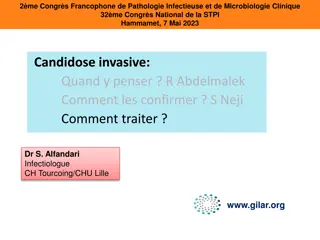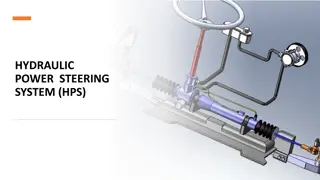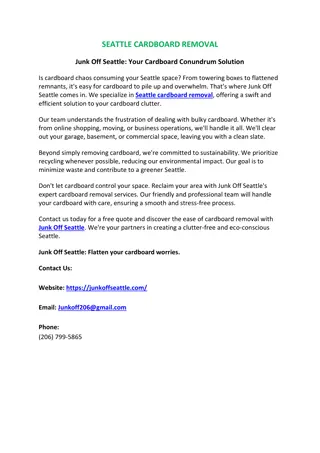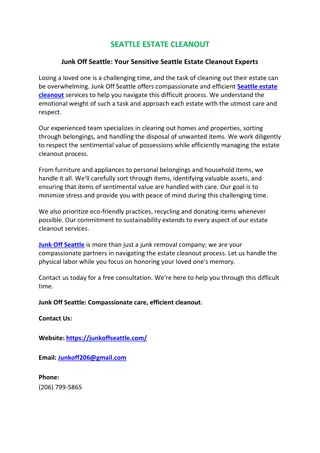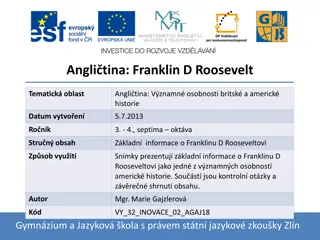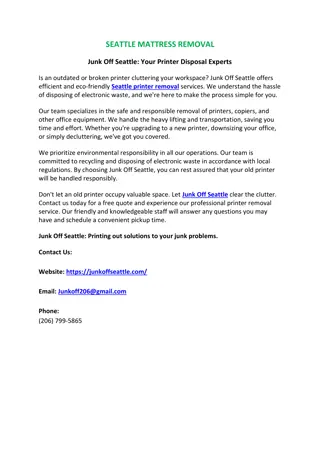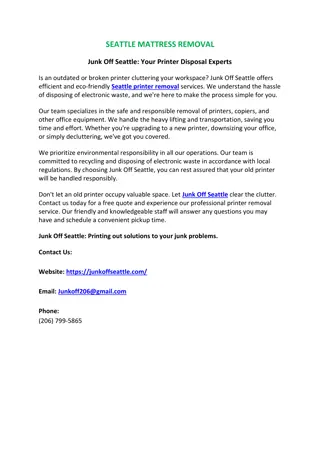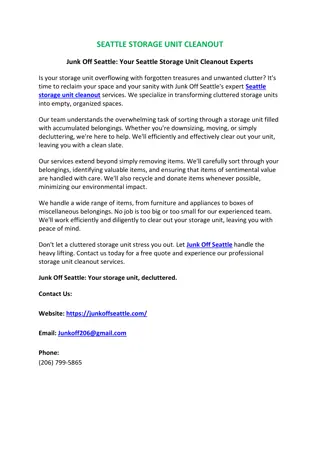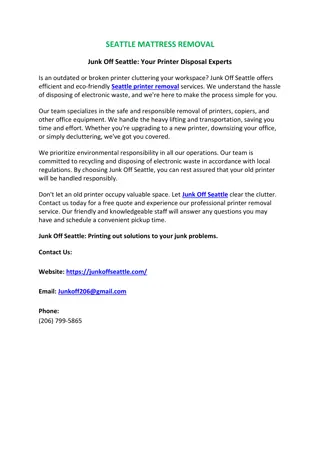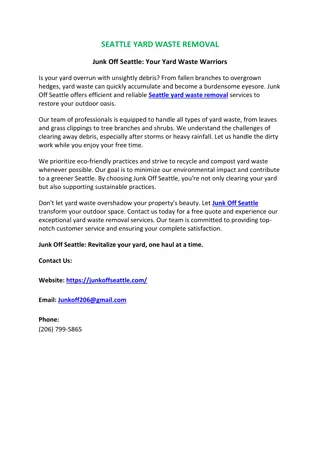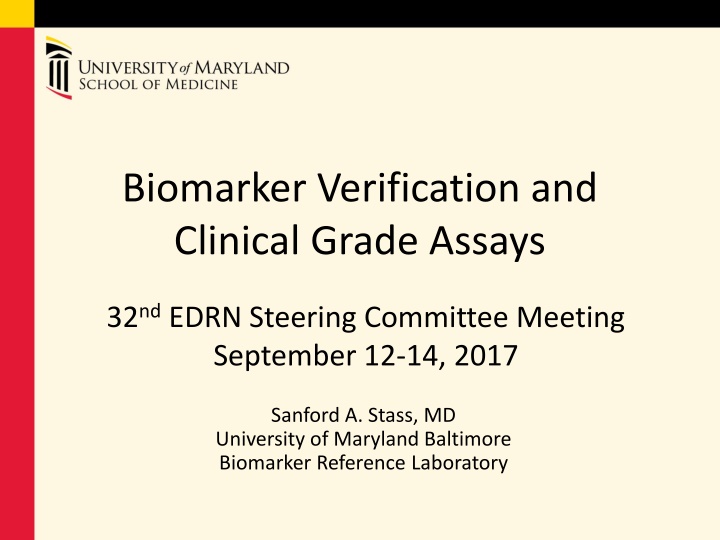
Clinical Laboratory Standards and Quality Assurance Overview
Learn about the importance of clinical laboratory standards, including the Clinical Laboratory Improvement Amendments (CLIA) and accreditation by organizations like the College of American Pathologists (CAP). Discover common causes of inaccurate results in lab testing and how to ensure quality in biomarker verification and clinical grade assays.
Download Presentation

Please find below an Image/Link to download the presentation.
The content on the website is provided AS IS for your information and personal use only. It may not be sold, licensed, or shared on other websites without obtaining consent from the author. If you encounter any issues during the download, it is possible that the publisher has removed the file from their server.
You are allowed to download the files provided on this website for personal or commercial use, subject to the condition that they are used lawfully. All files are the property of their respective owners.
The content on the website is provided AS IS for your information and personal use only. It may not be sold, licensed, or shared on other websites without obtaining consent from the author.
E N D
Presentation Transcript
Biomarker Verification and Clinical Grade Assays 32nd EDRN Steering Committee Meeting September 12-14, 2017 Sanford A. Stass, MD University of Maryland Baltimore Biomarker Reference Laboratory
Clinical Laboratory Improvement Amendments (CLIA) CLIA-88(final regulations published in 1992): Concerns arose regarding quality of laboratory testing (cholesterol screening, Pap smears). Law requires laboratories doing testing for diagnosis, prevention, or treatment of any disease or impairment of, or the assessment of the health of human beings be certified (initially by HCFA, now by Center for Medicaid and Medicare Services (CMS).
Clinical Laboratory Improvement Amendments (CLIA) (Cont d) The Clinical Laboratory Improvement Amendments (CLIA) (est. 1988, finalized 1992, and revised 2003). CMS regulates all laboratory testing through CLIA CLIA addresses issues of good laboratory practice, such as: Equipment maintenance Proficiency testing Competency testing Personnel training and documentation Result reporting CLIA does NOT address clinical utility, test sensitivity, result interpretation
College of American Pathologists (CAP) World s largest pathologists association. Leader in laboratory quality assurance. Federal government recognizes CAP as equal to or more stringent than the government s own inspection program. Deemed status with CLIA. CAP accreditation awarded (7,585 US and 381 International laboratories) by Commission Laboratory Accreditation based on results of stringent on site inspection every two years including examination of: Standard operating procedures/laboratory records Quality control procedures/quality assurance programs Qualification of directors and staff Laboratory equipment Facilities Safety Program Overall laboratory management
What Can Cause Inaccurate Results? Pre-analytic errors Collecting sample from wrong patient Collecting the wrong sample Mislabeling or failing to label sample Storing sample incorrectly prior to testing Improper Transportation of samples Damaged reagents or test kits 2017 College of American Pathologists CAP and Accreditation Overview 2017 5
What can Cause Inaccurate Results? Analytic errors Failing to follow an established algorithm Reporting results when QC tests out of range Incorrect sample or reagent measuring Using improperly stored or expired reagents Instrument calibration bias Reporting results beyond acceptable linearity range Conducting testing in wrong test mode 2017 College of American Pathologists CAP and Accreditation Overview 2017 6
Laboratory Errors Happen Root Causes? Training Competence Environment Policies and Procedures Test system performance Understandable report created with an effective interpretation Data suggests that 24-30% of laboratory errors have an effect on patient care while actual or potential patient harm occurs in 3-12%. 1 1. Hawkins R. Managing the Pre- and Post-analytical Phases of the Total Testing Process. Ann Lab Med 1012;32:5-16. 2017 College of American Pathologists CAP and Accreditation Overview 2017
CAPS Accreditation Program helps laboratories achieve these outcomes using: 21 discipline specific checklists that are a blueprint for running a high quality laboratory. ~ 40% of requirements exceed federal requirements and reflect the more stringent standards of CAP. Peer inspection model focuses on education and information sharing. Specialty inspectors for emerging high complexity areas Proficiency testing monitoring beyond regulated analytes because all tests should be done correctly 2017 College of American Pathologists CAP and Accreditation Overview 2017
Standards and Checklists Purposes: Standards are the broad principles the laboratory must meet in order to achieve accreditation. Checklists provide detailed requirements that inspectors use to determine whether laboratories meet the Standards . 2017 College of American Pathologists CAP and Accreditation Overview 2017
CAP 2-year accreditation cycle covers the entire lab Application Self Inspection Onsite Inspection Report Inspection Results to CAP Accreditation Decision CAP Review of Deficiency Responses Deficiency Responses 10 2017 College of American Pathologists CAP and Accreditation Overview 2017
Standard Operating Procedures (SOPs) CLIA/CAP Compliance Specimen Handling/Specimen Rejection Criteria/Specimen Storage Principle/Procedure Equipment Supplies Controls/Reagents/Reagent Preparation Quality Control/Criteria for Controls Interpretation and Procedure Limitations Troubleshooting Guide References
Specimen Handling Specimen collection and handling: Methods for collection Proper labeling Method for delivery Method for specimen preservation Procedure for safe handling Proper recording of specimens received
Specimen Handling (contd) Criteria for rejection. No aliquot is ever returned to the original container. Aliquoting procedure prevents any possible cross- contamination. Schedule for retaining specimens. Verifyidentity and integrity through all steps. Condition documented upon receipt (evidence of tampering, inadequate volume, etc.) Specimens limited access, secured area.
Equipment Validation/Quality Control (QC) New equipment clinically validated . All equipment regular Q.C. Q.C. records reviewed monthly. Records maintained in Q.C./Troubleshooting Notebooks. SOP for set-up/normal operation of equipment. Instructions/regular schedule for checking critical operating characteristics. Function checks to detect trends/malfunctions. Tolerance limits for acceptable function. Instructions for troubleshooting/repairs. Surveys to include UV/VIS spectrophotometer and analytical balance.
Equipment Validation/QC (contd) Document repairs/service procedures/maintenance. Spectrophotometer wavelength calibration checked regularly. All calibration curves rerun/verified after servicing or equipment recalibration. Criteria for acceptable background levels taken regularly.
Equipment Validation/QC (Contd) Temperatures checked/recorded. Water baths, Heating blocks, Incubators and ovens, Refrigerators and freezers Individual wells (or a representative sample thereof) of thermocyclers checked for temperature accuracy pre and post placed into operation.
Miscellaneous Supplies Volumetric glassware of certified accuracy (Class A, NIST Standard or equivalent). Non-certified volumetric glassware must be checked for accuracy of calibration before initial use and at specified intervals. Reconstitution of lyophilized calibrators, controls or proficiency testing materials, or any other tasks requiring accurate volumetric measurement, performed with measuring devices of Class A accuracy, or those for which accuracy has been defined and deemed acceptable for the intended use. Appropriate thermometric standard device (e.g., NIST certified) for calibration checks. All non-certified thermometers checked against an appropriate thermometric standard device.
Controls/Reagents/Reagent Preparation Document QC of reagent shipments of the same lot number New reagent lots checked against old reagent lots or with suitable reference material before or concurrently when placed in service. Appropriate validation studies performed/documented for use of any reagents that do not follow manufacturer s recommendations. Reagents/solutionsproperly labeled: Content and quantity, concentration or titer Storage requirements Date prepared or reconstituted by laboratory Usedwithinlabeled expiration date.
Quality Control/Quality All SOPs set specific criteria for controls. Tolerance/acceptability limits defined for all control procedures, control materials, and standards. All assays include external positive, negative, and amplification controls as QC for the specific assay. Distinguish a true negative result from false negative due to PCR failure. False negatives are often due to PCR inhibitors in the specimen; demonstrate that a different DNA/RNA sequence from the one being tested is amplifiable in the same specimen. Evidence of corrective action when control results exceed defined tolerance limits. Unacceptable controls documented on worksheet/Troubleshooting Notebook. Quantity/quality (intactness) high molecular weight DNA/RNA assessed. Nucleic acids processed promptly/stored adequately to minimize degradation.
Interpretation of Results Criteria for assay parameters/data interpretation. Clearly define interpretation guidelines resulting in a level of consistency between laboratories and clear delineation of positive, negative, or indeterminant results.
Personnel Training & Competency Training new staff. Annual training/evaluation includes: Annual competency tests using in-house blind samples, CAP/CDC survey/exchange samples, or written tests. A minimum of 8 continuing education hours. HIPAA, Compliance, and Safety/Hazard training.
Experience with BDL to UMB-BRL Assay Development and Implementation Lessons Learned
MSA Assay Validation for Detection of Bladder Cancer SOP/Qualification This assay consisted of Short Tandem Repeat PCR analysis of 15 previously validated microsatellite markers located within 14 gene loci (D4S243, D21S1245, FGA, D17S695, D16S476, D9S171, IFN-A, D20S48, D17S654, D16S310, TH01, D9S162, D9S747, MBP and MBPa). Implementation issues between commercial and UMB-BRL CLIA/CAP laboratories. Difference in Primer pairs used Need for new Positive Control Refinement of SOP with regard to interpretation and acceptance criteria New reagents (PCR master mix and HLPC primers) Clear definition of interpretation guidelines that result in level of consistency between laboratories Clear definition of all aspects of these assay parameters in the SOP
Assay Development/Validation of GP73 Biomarker for Hepatocellular Carcinoma Glycoproteomic studies suggest hepatocellular carcinoma has greatly elevated serum levels of total and fucosylated forms of normal Golgi resident glycoprotein (GP73) compared to cirrhosis. Collaboration with Dr. Timothy Block (Drexel University) established ELISA for quantitative GP73. Confirmed reagents and materials for the quantitative GP73 assay and establishedSOP with CLIA/CAP standards for assay in the UMB-BRL using LiCor equipment. Parallel testing for the quantitative GP73 assay with Dr. Block s research laboratory established that the ELISA assay demonstrated inter-laboratory (100% concordance) using the LiCor equipment, indicating successful transfer of the assay from Dr. Block s laboratory to the UMB-BRL CLIA/CAP laboratory. The Licor would not be the most likelyequipment used in the clinical laboratory. LiCor optics is not as sensitiveresulting in false negatives. The Liaison, or a like system that uses chemoluminescent technology, is a better fit for clinical laboratory since it is more sensitive and would result in fewer false negatives.
Application of a Vimentin Gene Methylation Potential Biomarker for Colon Cancer Transfer of Vimentin Gene Methylation Assay from BDL (Sanford Markowitz, MD, PhD, Case Western Reserve University) to UMB-BRL CLIA/CAP Laboratory Methylation specific quantitative real-time PCR (qRT-PCR) Assay Pre-validation Study Issues Investigation of difference in results between BDL and UMB-BRL: UMB-BRL sent technologist to BDL to process the same set of samples side-by-side using the same SOP, reagents, and equipment. The BDL and UMB-BRL staff obtained identical results for this exercise. Conclusion: These differences likely due to the sensitivity of the equipment. ABI 7900 HT Laser dye excitation Less sensitive/stable optics Solution UMB-BRL purchased BioRad CFX96 equipment BioRad CFX96 LED dye excitation Sensitive, solid state digital optics 25
Potential Biomarker for Colon Cancer Transfer of Vimentin Gene Methylation Assay From BDL (Case Western Reserve University) to UMB-BRL CLIA/CAP Laboratory (Cont d) PCR Amplification Buffer affects sensitivity Roche buffer (Essential) vs. ABI Taqman universal buffer. The Roche buffer produced lower Ct values (mid high 20 s to low 30 s) which improves assay sensitivity vs Taqman (high 30 s to 40 s). Therefore, the Roche buffer was used. Reagents (e.g. buffers) were verified, optimized and standardized for clinical application. The UMB-BRL implemented HPLC purified primers and probes. Certain elements of the assay were modified to adapt to CLIA/CAP standards Inclusion of standard curve using CpGemone DNA, etc. The UMB-BRL implemented use of diluted CpGenome DNA (methylated and unmethylated) versus diluted cell line. Evaluation of DNA clean up on the stool samples Repeat testing of previous pre-validation study samples demonstrated a high degree of concordance between BDL and UMB-BRL. Specimen processing SOP for samples received at UMB-BRL developed.
Overview Implementing BDL Laboratory Assays into CLIA/CAP-Compliant Assays Issues/Lessons Learned Paper Towel Syndrome Lack of organized SOP without clear definition of all assay parameters (e.g. fragmented SOP written on paper towels, isolated notes in lab coat pockets, etc.) Modification of SOPs BDLs may have used assays prior to discovery/development of a biomarker. SOPs may have been modified on an ongoing basis without documentation/rationale making it difficult to implement/evaluate assay efficacy. Consistency of assay performance Alternate methods/different technologists Staff training Appropriate training Potential for inconsistencies in running assay from batch to batch Assure staff complies with procedures as delineated in SOP and assure different staff do not do it their own way 27
Overview Implementing BDL Laboratory Assays into CLIA/CAP-Compliant Assays Issues/Lessons Learned (Cont d) Compliance with CLIA/CAP QC Standards Standard controls or presence of controls in assay. Equipment calibration, SOP, records, validation, QC, maintenance and monitoring, including pipet QC Reagent QC including, source, tracking by lot and shipping number, storage conditions; HPLC grade not used Kits used for testing not at clinical level (e.g. kits purchased outside U.S. which may not meet clinical standards) and contents mixed QC of in-house reagents and expiration dates The same model of equipment/platform or different equipment may not function the same and produce comparable results between the developmental laboratory and the BRL. Alternate methods used in the BDL for the same assay by different technologists or same assay performed differently by technologists in BDL makes it difficult for BRL to develop CLIA/CAP SOP. Lack of clarity on how BDL calculates results Reagents not stored at proper temperatures; temperatures of refrigerators/freezers not recorded BDL assays may use equipment that is not in general use in a clinical laboratory Budget comparisons between BDL and BRL may be different due to differences in final BRL assay. Interpretation guidelines/results must be developed based on validation and be clearly defined
BRL and BDL CLIA/CAP Assay Recommendations If you don t know where you are going you might end up some place else Yogi Berra
BRL and BDL CLIA/CAP Assay Recommendations BDL and BRL communicate early in the process of assay development/implementation for testing in a CLIA/CAP laboratory. Perform unblinded parallel studies between BDL and BRL during assay development/implementation to assess efficacy of all assay parameters. 30
BRL and BDL CLIA/CAP Assay Recommendations (Cont d) Clearly validate and define interpretation guidelines that result in consistent agreement between BDL and BRL Early identification by the BRL of promising platform(s) used by BDLs so BRLs will be prepared for technology transfer Assays used by BDLs may not be in use in BRLs/clinical laboratories or are assay adaptations. BRLs need to learn and optimize reliability of these assays early in the process Clearly define all aspects of assay parameters in the SOP Continued parallel testing as the biomarker development laboratory develops and the BRL evaluates biomarker(s) for clinical implementation Incorporate well defined quality assurance oversight/methods to provide more consistent results throughout the development and implementation process 31
UMB-BRL Core Facilities and Resources Potential Areas of Collaboration with Other Members of EDRN Extensive laboratory technology and testing experience including translation of biomarkers research into direct CLIA/CAP clinical laboratory testing in a stringent environment required by regulatory agencies (federal and state) to assure quality patient testing. University of Maryland Baltimore (UMB), University of Maryland School of Medicine (UMSOM) and Off-Campus Core Facilities and Resources Laboratories of Pathology CLIA/CAP/ASHI/FDA Accredited Anatomic and Clinical Pathology Sanford Stass, MD University of Maryland Medical Center Pathology/Medicine Laboratory CLIA/CAP Accredited Genomic Technologies Core Facilities and Resources Translational Genomics Laboratory Linda B. Jeng, MD, PhD Institute for Genome Sciences Claire M. Fraser, PhD Biopolymer/Genomics Core Facility Nicholas P. Ambulos, Jr., PhD Biostatistics Core Service S ren M. Bentzen, PhD, DMSc Molecular Diagnostics Laboratory Richard Y. Zhao, PhD Clinical Pathology and Research Laboratory Robert Christenson, PhD Cytogenetics Laboratory Ying Zou, MD, PhD Flow Cytometry Core Laboratory Immunogenetics Laboratory Debra KuKuruga, PhD UMB, UMSOM UMSOM UMSOM Information Technology, Informatics and Biostatistics Pathology Laboratory CLIA/CAP Accredited Pathology Laboratory CLIA/CAP Accredited UMSOM UMSOM UMSOM Pathology Laboratory CLIA/CAP Accredited Pathology Laboratory CLIA/CAP and ASHI Accredited UMSOM UMSOM
UMB-BRL Core Facilities and Resources Potential Areas of Collaboration with Other Members of EDRN University of Maryland Baltimore (UMB) and Off-Campus Core Facilities and Resources Structural Biology/Mass Spectrometry/Proteomics BIACore Core Facility Robert Bloch, PhD Center for Mass Spectrometry Resources Maureen A. Kane, PhD Nuclear Magnetic Resonance Center David J. Weber, PhD (Dir.) Kristen M. Varney, PhD (Manager) X-ray Crystallography Core Facility Eric Sundberg, PhD Computer Aided Drug Design Center Alex MacKerell, PhD UMSOM University of Maryland School of Pharmacy (UMSOP) UMSOM and UMSOP UMSOM Drug Development Core Facilities and Resources UMSOP Center for Nanomedicine and Cellular Delivery Peter Swann, PhD Center for Fluorescence Spectroscopy Joseph Lakowitz, PhD Confocal Microscopy Core Facility Thomas Blanpied, PhD Electron Microscopy Core Facility Ru-ching Hsia, PhD Center for Translational Imaging Rao Gullapalli, PhD Magnetic Resonance Research Center Rao Gullapalli, PhD Tissue Bank Core Laboratory Olga B. Ioffe, MD UMSOP Imaging Core Facilities and Resources UMSOM UMSOM UMSOM and UMSOP UMSOM UMSOM Pathology Laboratory University of Maryland Marlene and Stewart Greenebaum Comprehensive Cancer Center
UMB-BRL Core Facilities and Resources Potential Areas of Collaboration with Other Members of EDRN University of Maryland Baltimore (UMB) and Off-Campus Core Facilities and Resources Mid-Atlantic Shared Services Consortium Metabolomics & Glycomics Amrita Cheema, PhD Radoslav Goldman, PhD Analytic Pharmacology Michelle Rudek, Pharm D, PHD Cell Processing and Gene Therapy Facility M. Victor Lemas, PhD Georgetown Lombardi Comprehensive Cancer Center Sidney Kimmel Comprehensive Cancer Center at Johns Hopkins Biomolecular Magnetic Resonance Facility Jeff Ellena Biomedical Mass Spectrometry Laboratory: Proteomics Nicholas Sherman Molecular Imaging Core Stuart Berr Flow Cytometry Facility Joanne Lannigan Lymphocyte Culture Center: Monoclonal Antibody Production Bill Sutherland University of Virginia Cancer Center


